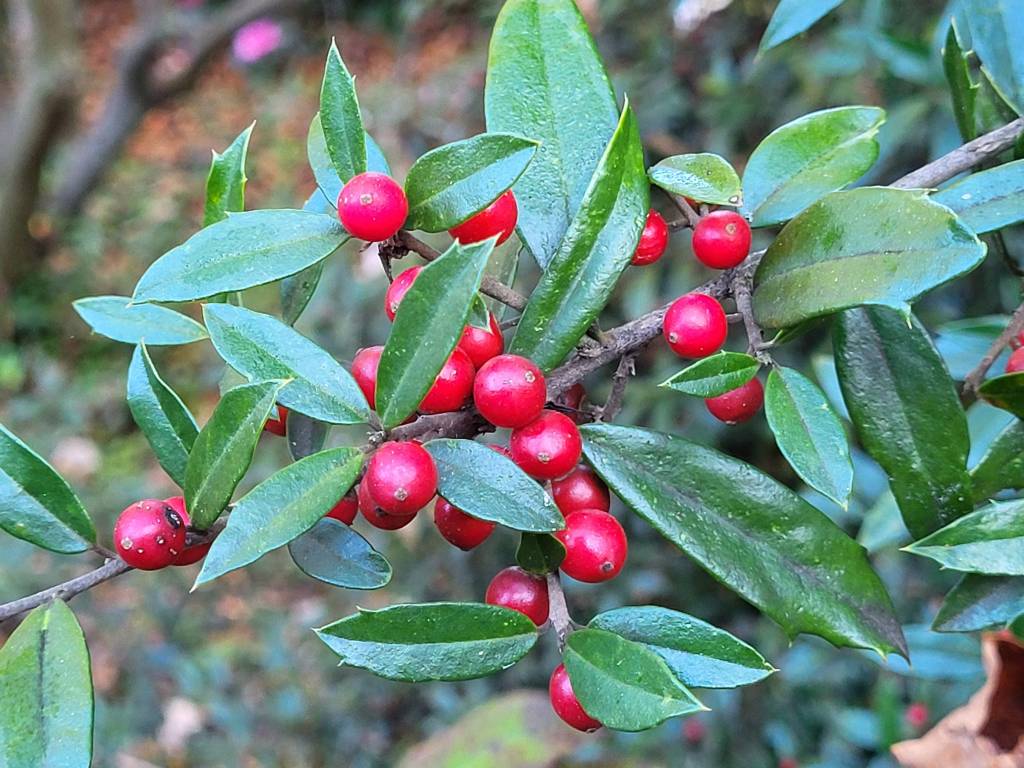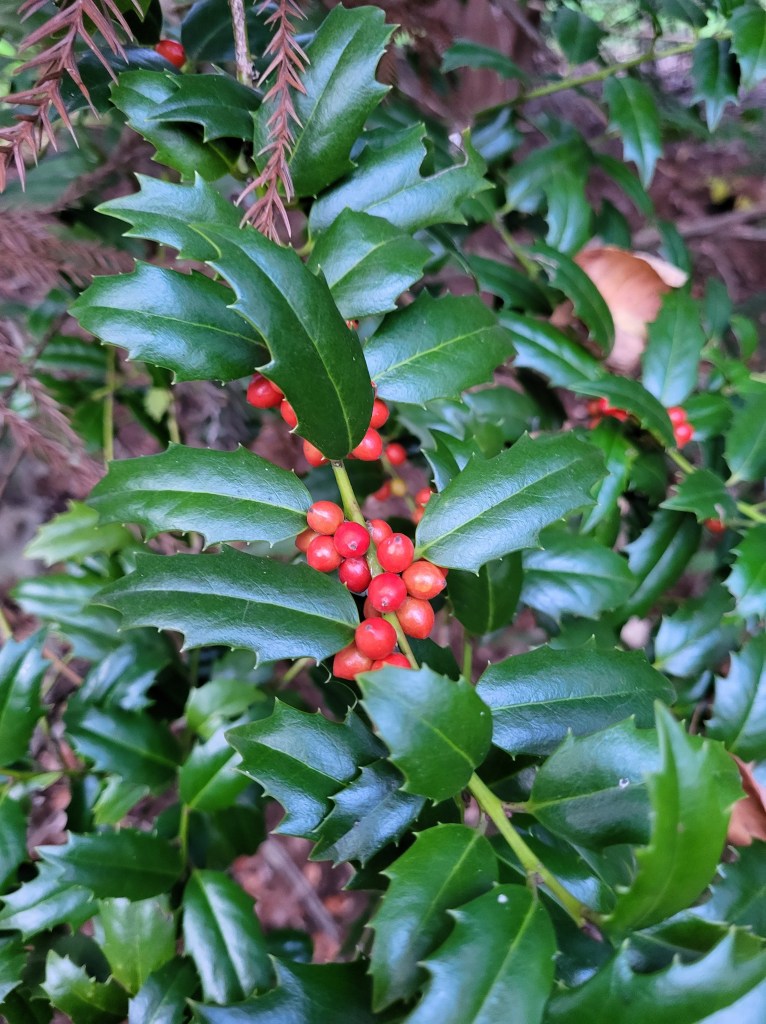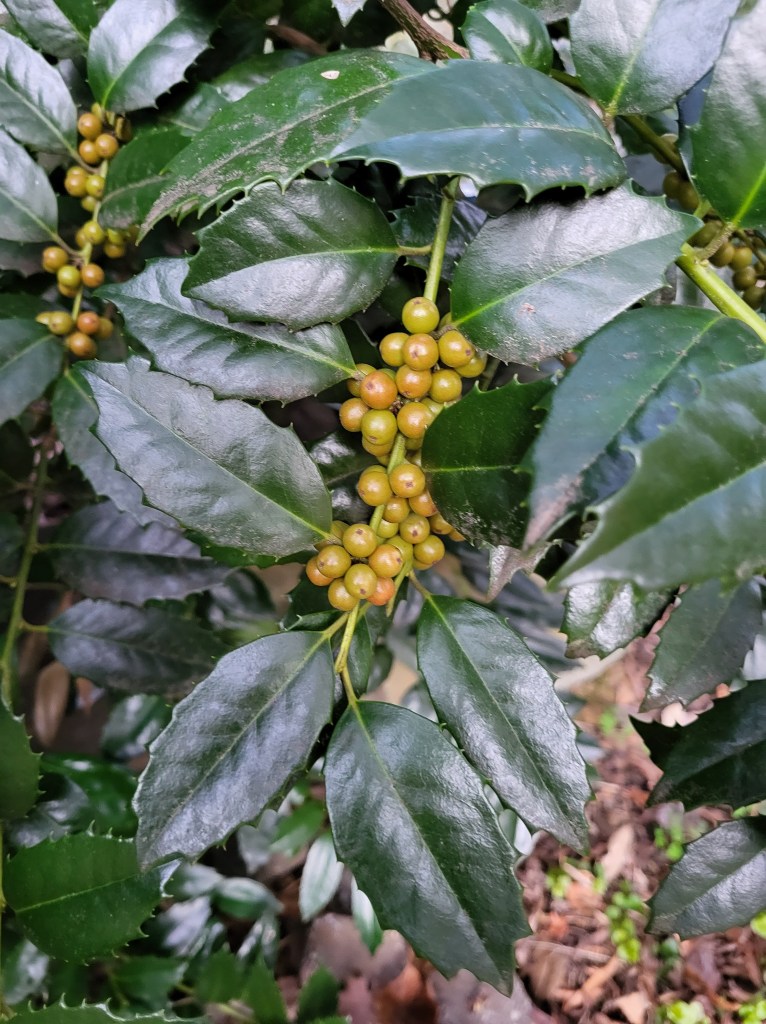This is an off year for the Koehne holly (Ilex koehneana) that is typically the most dependable and heaviest to berry in the garden. There are scattered berries, but not in the quantity seen every other year.

Unfortunately, lower branches were removed recently as the huge holly strayed too far over the driveway. The newly exposed trunk is attractive enough, but the lower branches were also ones where berries could be most readily viewed. Fortunately, there are other hollies nearby with plentiful berries, though I think the crop overall is less than typical. I blame bees, or at least the weather at the time when the hollies were flowering. Colder temperatures mean fewer bees, and fewer berries.

Until recent years, a ‘Dixie Star’ holly (above) was hidden beneath a wide spreading ‘Jane’ magnolia. For whatever reason, after a few decades it decided to take a leap upwards and out of obscurity. This holly was a trial for a plant that I don’t believe was ever introduced, and certainly it was not a significant improvement over other available hollies. Thus, it was shoehorned into a space, but now I’m happy to have it.

The small collection of large growing hollies was planted because I like to have some evergreens scattered about, but mostly to trial hollies as those of us in the garden industry considered alternatives to the very popular Nellie R. Stevens holly (above). All of the introductions are fine plants, and several have been around for a few decades now, but none have diminished Nellie’s popularity.

Unfortunately, a large ‘Christmas Jewel’ holly was removed recently as the construction began for our new sunroom. The holly was just far enough away from the room as far as I was concerned, but Barbara did not want any tall plants obstructing the view. Too often, I ignore her opinions on the garden, so I must trumpet my agreement that removed this decades old treasure. A second ‘Christmas Jewel’ (above) suffers in shade that is far too deep in the lower, rear garden, but this is an exceptional holly that grows a bit smaller than the others that top out above twenty feet.

Beside the ‘Christmas Jewel’, and also too shaded beneath a decades old katsura (Cercidiphyllum japonicum), is a ‘Patriot’ holly (above) that was once introduced as part of a group that was touted as Red Hollies for their red new growth. If ‘Patriot’ exhibited this growth, it was never evident to me, and while it’s a fine holly, it faded into obscurity along with many dozens of others that have no outstanding attribute to stand above others.

While most of the garden’s hollies are cultivars or hybrids of the Chinese holly (Ilex cornuta), there are scattered native American hollies (Ilex opaca, above). All were native seedlings, and none were planted, though a few have been moved around a bit. Only one of the native hollies appears to be a female, though several are young enough that they would not have berries yet. The large female holly (above) grows in the middle of other large trees and evergreens, so only a few berries are present on the few, weak lower branches.

As hollies were introduced in recent decades, a few oldtimers were kicked to the side, but some remain excellent plants. A favorite of mine is ‘Mary Nell’ (above). It is similar to other hollies and as many, it is indistinguishable from twenty feet away, but it berries heavily and it has a densely branched, pyramidal form.

There are other hollies in the garden that stand out in autumn as trees drop their leaves, but none stand out like the variegated English holly (Ilex aquifolium ‘Argentea Marginata’, above) despite a lack of berries. I suppose this is a male holly, but it’s possible there are no pollinators around when it is flowering. It would be exceptional with red berries, but it’s a splendid holly without.

At last, the question is, how do the hollies contribute to feeding the garden’s abundant wildlife? While berries are too few on the native American hollies for comparison, I am annually disappointed that most berries (not only hollies) are not quickly eaten by birds. Berries of dogwoods, native and non-native are eaten as son a they ripen, but berries of hollies often persist into late winter when some are eaten by robins. In this garden we have many birds and berries, but only a fraction of berries are eaten.